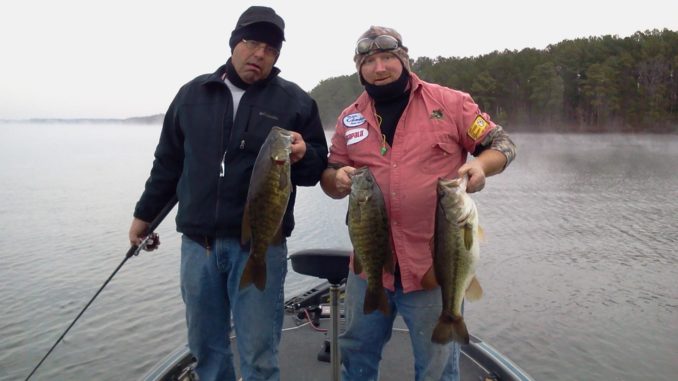
Crankbaits fished on lower end of lake producing great catches
Lake Monticello is unique in many ways, one being that it’s a pump-back type reservoir that puts warm water into the lake during cold weather. It’s also unique because it’s one of the few lakes in South Carolina that consistently produce quality smallmouth bass. George Buckner and Greg Darr, both from Aiken, have been making excellent catches of both smallmouth and largemouth at Lake Monticello recently. In addition, they have been doing it in relatively shallow water using crankbaits.
“We’re working different patterns, including just simply running crankbaits around rocks off points as well as fairly shallow humps on Lake Monticello,” Buckner said. “I’ve been fishing this lake since the 1980s, but about a dozen years ago (I) started seeing smallmouth show up. On one recent trip, we had two smallmouths in the 5-pound class and a 7-pound largemouth, among several other hefty bass. The fishing is really good right now, and the cold weather is a key to keep the fish going strong.”
Buckner said that the January and February are his favorite months to catch big smallmouth and largemouth on Monticello because of the warmer water pumped back into the lake.
“One of the keys to catching these big smallmouth and largemouth at this time of year is fishing the lower end of the lake,” he said. “A good example is what we saw the other day. We launched the boat at the upper end of the lake – there are only two ramps on the lake – and the water temperature was 50 degrees. When we got to the lower end of the lake, the water temperature was about 60 degrees. That creates an entirely different situation for bass. The warmer water has the shad in the area in huge numbers, and these fish are feeding on those shad.
“We’re finding fish off points, and especially for smallmouth, we like points with clusters of rocks in 10 to 14 feet of water,” he said. “For largemouth, we’re catching some really big fish in three to eight feet of water off the points and even around shoreline objects. Find some deeper rocks and work a flat-style crankbait for smallmouth and a Shad Rap for largemouth. Crawfish patterns are great for both species. I use 8-pound test line so my lures will get into that 10- to 14-foot depth range. Sometimes, we’ll use our electronics and graph a point and find a rockpile with fish depicted around the rocks. If we position the boat correctly we’ll usually catch multiple fish, mostly smallmouth.”
“One key is, because of the warmer water in that part of Lake Monticello, the speed on the crankbait is actually pretty fast – much like fall fishing,” he said. “The bass don’t care that it’s January or February; they just know its 60-degree water, and they react to that.”
Buckner said to make sure you don’t motor downstream past the markers that depict the off-limits area in an arc around the dam.
Buckner said that because the water will fluctuate, he sometimes has to use a spoon to get down to where the smallmouth are holding, but generally a crankbait will get the job done.
“I fish all the lakes in the state, and I rate Monticello as tops for smallmouth, especially at this time of the year,” he said. “That’s why we go there.”


Be the first to comment